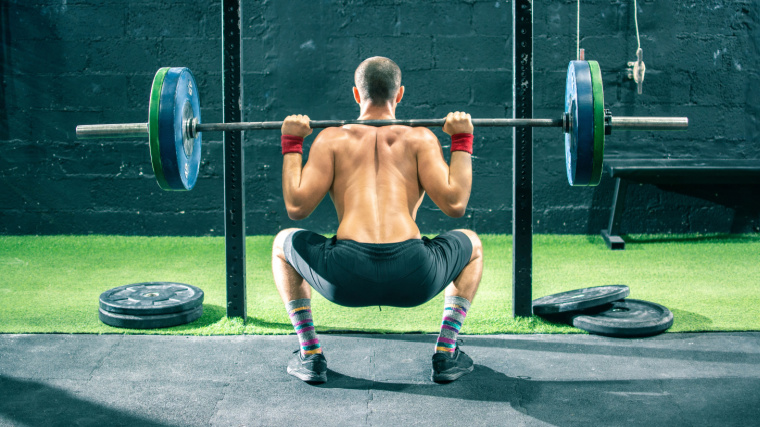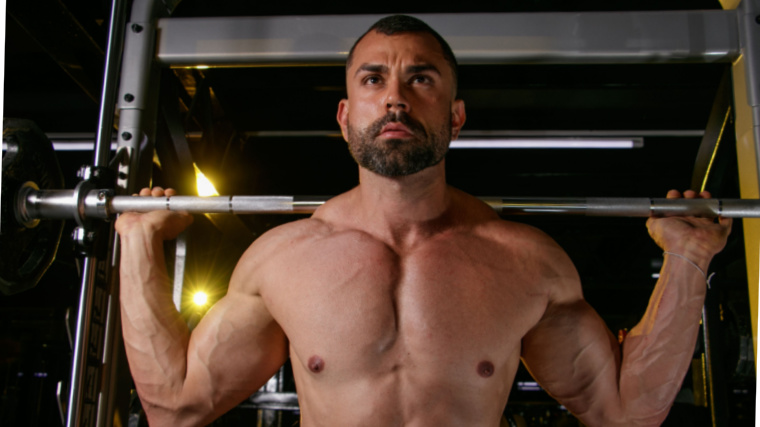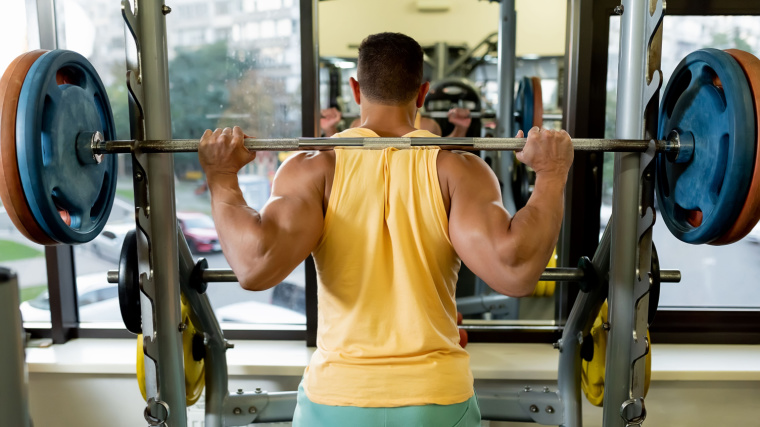Are Squats Really More “Anabolic” Than Other Exercises? (original) (raw)
Your Takeaways
- Informally, an exercise like the squat is described as “anabolic” based on the supposition that it leads to increases in muscle-building hormones like testosterone.
- Squats are thought to be more anabolic than other movements because they involve a large number of individual muscles.
- Research on the subject is mixed leaning negative.
- While heavy compound lifting does elevate certain anabolic hormones, these effects seem to dissipate within hours.
- Squats are a fantastic exercise for building lower-body strength and muscle, but not because they drastically elevate your testosterone levels in any practical way.
There are a lot of good reasons to squat. For starters, squats are tremendously effective at building muscle in your legs and hips. The squat is also one of your fundamental movement patterns, and mastering it will carry over to other aspects of both your workout routine and out-of-the-gym lifestyle.
Oh, and they’re probably the best overall movement for developing general lower body strength. If you hit the gym hard, whether as an aspiring bodybuilder, powerlifter, or you’re just a good ol’ gym rat, you may have also heard squats (particularly, barbell back squats) described as an “anabolic” exercise.

Credit: Bojan Milinkov / Shutterstock
More specifically, it’s a bit of longstanding — and perhaps too prevalent — bodybuilding lore that squats are the most anabolic exercise out there. This begs the question: What even is an anabolic exercise in the first place, and are squats really more anabolic than other exercises you commonly perform? Here’s what the science has to say on the matter.
Editor’s Note: The content on BarBend is meant to be informative in nature, but it should not be taken as medical advice. When starting a new training regimen and/or diet, it is always a good idea to consult with a trusted medical professional. We are not a medical resource. The opinions and articles on this site are not intended for use as diagnosis, prevention, and/or treatment of health problems. They are not substitutes for consulting a qualified medical professional.
Meet Our Expert
Dr. Pat Davidson is a PhD in Exercise Physiology and a full-time strength coach with decades of experience in the gym as both an athlete and instructor.
What Does Anabolic Mean?
Your body is constantly at work. From digesting the foods you eat to synthesizing and utilizing energy, your internal machinery never takes a rest day. This applies to anabolism and catabolism as well, which broadly refer to building or repairing and breaking down or eliminating organic material, respectively.
More specifically and among fitness enthusiasts, “anabolic” is used as a general stand-in for, “directly builds or encourages the building of muscle tissue.” Protein powder supplements could be informally considered anabolic because your body requires the amino acids within to facilitate hypertrophy, or muscle growth.
By extension, gymgoers sometimes refer to aspects of their training as anabolic as a form of gym slang, by which they mean how effective or potent at building muscle an exercise (or entire routine) is.
So, why are squats regarded as particularly anabolic (that is, especially effective at stimulating a general muscle-building atmosphere)?
When you perform strength training, you do more than simply tax your muscle tissue. All sorts of metabolic interactions take place during and after your workout. Lifting weights elicits a response from your endocrine system, elevating your testosterone levels in the process.

Credit: Valtinho Fotografia / Shutterstock
[Read More: How to Do the Hack Squat, the Squat Alternative You’re Missing]
The harder you work, or the more work you do, the more intense this hormonal response is, and the more testosterone is produced as a consequence.
So, logically, it kind of makes sense that a large compound exercise like the squat would stimulate more testosterone than something “smaller” like a biceps curl. That’s the core idea behind squats being more “anabolic” than other exercises. But does it stand up to scientific scrutiny?
What the Science Says
There are a surprisingly large number of studies analyzing the hormonal impact of resistance training exercises like the squat.
Most data involve measuring the impact of squats (whether with a barbell or other implement) on the secretion of testosterone, growth hormone, insulin-like growth factor (IGF-1), and cortisol. Each of these compounds plays an important role in muscle anabolism.
- A 2018 study on almost 30 experienced powerlifters concluded that a moderate volume of high-intensity squats “may play a significant role” in stimulating muscle growth from a hormonal perspective. (1)
- One analysis studying hormonal effects on younger and older men showed that heavy squats mildly raised testosterone in young participants, lowered it in some older adults, and had no significant effect on growth hormone in either group. (2)
So, a handful of studies have shown mixed results regarding the hormonal impacts of squats. However, there’s a larger breadth of data looking at the acute hormonal effects of heavy weight training in general:
- This study notes that resistance training can produce substantial acute changes in anabolic hormones, but these elevations may not last long enough to be meaningful in all cases. (3)
- A 2009 paper made a strong assertion that weight training does not meaningfully enhance post-exercise muscle protein synthesis from a hormonal perspective specifically. (4)
- Other data have shown spikes in anabolic hormones following resistance exercise, but the relative increase in hormones like testosterone is both temporary and not necessarily significant in its own right. (5)
So, what do all these data mean? Lifting weights — which certainly includes squats — does increase your anabolic hormone levels. And the heavier and harder you train, which squats certainly require you to do, ostensibly increase these hormones even further.
However, these changes in anabolic hormone levels appear to be temporary; the bump in concentrations of testosterone or IGF-1 returns to baseline within hours.

Credit: BalanceFormCreative / Shutterstock
[Read More: The Split Squat Can Improve Mobility and Leg Strength]
Moreover, the elevation of anabolic hormones themselves may not be significant enough to stand on their own merit. Some studies show increases of less than 50ng/dL during and after a workout; most adult males maintain anywhere from 300 to 1,000 ng/dL of testosterone in their system by default. (6)
In the simplest terms, squats may technically be more anabolic than other exercises. But that doesn’t mean that squatting heavy will significantly change how much testosterone or growth hormone you have in your body, especially not long term.
An Expert’s Opinion
Studies appear to show very mixed results regarding the anabolic “potential” of squats. But what does an industry expert think? Davidson isn’t sold on the premise:
“The spikes in [anabolic hormones] that have been observed in response to certain protocols of resistance training have been deemed irrelevant to muscle hypertrophy signaling,” he says. “These hormones return back to baseline in a short time scale. The variables that matter [for muscle growth] are progressive overload, a calorie surplus, and lifestyle management like sleep and stress reduction.”

Credit: EA230311 / Shutterstock
[Read More: The 10 Best Squat Racks]
Further, Davidson remarks that anabolic steroids are so potent precisely because they aren’t as intermittent as the bump in hormones you might get from a squat workout. Put simply; you can’t realistically squat heavy or often enough to generate enough anabolic hormones to make a real impact on how your body grows muscle.
How to Increase Testosterone
The scientific community may be mostly against the idea that squats are a magic bullet for elevating your anabolic hormones in any meaningful real-world way. However, that doesn’t mean there’s nothing you can do if you want to maximize your testosterone levels for the purpose of gaining more muscle and strength.
Here are a couple of easy-to-implement strategies that have a bit of scientific backing behind them:
- Keep tabs on your training volume. Some studies have shown that too much lifting can actually lower your testosterone levels. (7)
- Eat more dietary fat, particularly saturated fat. There are several studies showing that diets higher in these types of fat can sometimes increase testosterone levels by as much as 13 to 15 percent. (8)
- Taking a vitamin D supplement or getting more sun exposure may help as well, with certain studies showing small but noteworthy effects on testosterone levels. (9)
Benefits of Squats
Squats may not jack up your testosterone levels, but that doesn’t mean they’re not a world-class banger of an exercise.
[Read More: How to Do the Sissy Squat to Build Heaps of Muscle Without Weights]
By adding some form of squat into your leg workouts, you can reap benefits like these.
They’re Time-Efficient
You can’t overlook the value of an exercise that saves you time in the weight room. Most people don’t have all morning or afternoon to dedicate to a workout — time-efficient exercises are indispensable.

Credit: chomplearn / Shutterstock
[Read More: How to Do the Sumo Goblet Squat — Benefits, Form, Variations, and More]
Squats work a large number of muscles simultaneously. They’re also pretty easy to set up and perform, once you have a grasp on the technique that is. If you’re strapped for time in the gym, a few hard sets of squats will accomplish about as much as three different isolation exercises.
Help You Build Strength
The key to increasing strength is time, patience, and effort. You need a movement that allows you to gradually progress in the amount of weight you lift; something you can chip away at over weeks and months.
[Read More: How to Do the Pistol Squat For Mobility and Leg Strength]
The squat shines here. Not only can you lift lots of weight with the barbell back or front squat, but you can also add small amounts of weight incrementally. An extra five pounds on your barbell may not feel like much, while moving the peg down a notch on the machine leg press can amount to a significant increase in difficulty.
Improve Balance and Coordination
You’ll find people in physical therapy clinics performing squats all the time, and for good reason. The ability to sit and stand while bracing against resistance is integral for both athletic performance and everyday life.
[Read More: Learn How to Box Squat to Lift More Weight and Improve Power]
Some squat variations, such as the goblet squat or single-legged squat, are particularly useful for improving balance and coordination. And the best part is you don’t necessarily need to lift super heavy to improve your stability.
How to Do the Barbell Back Squat
Squatting may not double your testosterone levels or turn you into some sort of anabolic monstrosity, but they’re still a darn good exercise that belongs in your program no matter your goals.
Here’s a step-by-step instructional on how to do the standard barbell back squat:

[Related: Back Squats vs. Front Squats — Comparison, Application, and Benefits of Each ]
- Step 1 — Set an empty or lightly loaded barbell into a squat or power rack at about the height of your clavicles.
- Step 2 — Get under the bar and brace it against the meat of your upper back between the backs of your shoulders and the base of your neck
- Step 3 — Plant your feet under the bar, grasp it with a moderate-width grip, and step backward out of the rack.
- Step 4 — Situate your feet between hip and shoulder width and turn your feet out to whatever degree is comfortable.
- Step 5 — Inhale and brace your core to stabilize your torso.
- Step 6 — Begin the squat by unlocking your hips and knees. Sit straight downward as low as you are able, or until the crease of your hip is lower than your kneecap.
- Step 7 — Push into the ground hard to reverse the motion and stand back up.
References
- Wilk, M., Petr, M., Krzysztofik, M., Zajac, A., & Stastny, P. (2018). Endocrine response to high intensity barbell squats performed with constant movement tempo and variable training volume. Neuro endocrinology letters, 39(4), 342–348.
- Kraemer, W. J., Häkkinen, K., Newton, R. U., Nindl, B. C., Volek, J. S., McCormick, M., Gotshalk, L. A., Gordon, S. E., Fleck, S. J., Campbell, W. W., Putukian, M., & Evans, W. J. (1999). Effects of heavy-resistance training on hormonal response patterns in younger vs. older men. Journal of applied physiology (Bethesda, Md. : 1985), 87(3), 982–992.
- Kraemer, W. J., & Ratamess, N. A. (2005). Hormonal responses and adaptations to resistance exercise and training. Sports medicine (Auckland, N.Z.), 35(4), 339–361.
- West, D. W., Kujbida, G. W., Moore, D. R., Atherton, P., Burd, N. A., Padzik, J. P., De Lisio, M., Tang, J. E., Parise, G., Rennie, M. J., Baker, S. K., & Phillips, S. M. (2009). Resistance exercise-induced increases in putative anabolic hormones do not enhance muscle protein synthesis or intracellular signalling in young men. The Journal of physiology, 587(Pt 21), 5239–5247.
- West, D. W., Burd, N. A., Tang, J. E., Moore, D. R., Staples, A. W., Holwerda, A. M., Baker, S. K., & Phillips, S. M. (2010). Elevations in ostensibly anabolic hormones with resistance exercise enhance neither training-induced muscle hypertrophy nor strength of the elbow flexors. Journal of applied physiology (Bethesda, Md. : 1985), 108(1), 60–67.
- Testosterone. Mount Sinai Hospitals. Retrieved 28 Nov. 2023.
- Häkkinen, K., & Pakarinen, A. (1991). Serum hormones in male strength athletes during intensive short term strength training. European journal of applied physiology and occupational physiology, 63(3-4), 194–199.
- Dorgan, J. F., Judd, J. T., Longcope, C., Brown, C., Schatzkin, A., Clevidence, B. A., Campbell, W. S., Nair, P. P., Franz, C., Kahle, L., & Taylor, P. R. (1996). Effects of dietary fat and fiber on plasma and urine androgens and estrogens in men: a controlled feeding study. The American journal of clinical nutrition, 64(6), 850–855.
- Pilz, S., Frisch, S., Koertke, H., Kuhn, J., Dreier, J., Obermayer-Pietsch, B., Wehr, E., & Zittermann, A. (2011). Effect of vitamin D supplementation on testosterone levels in men. Hormone and metabolic research = Hormon- und Stoffwechselforschung = Hormones et metabolisme, 43(3), 223–225.
Featured Image: Bojan Milinkov / Shutterstock